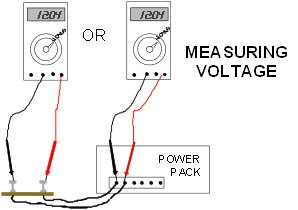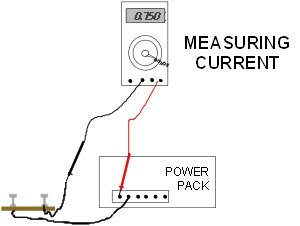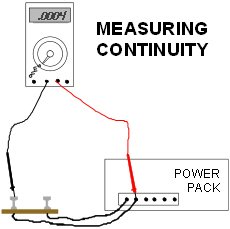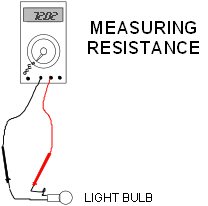Jim Currie suggested that I do a tutorial on the use of a VOM. His thinking is that every modeler needs this tool, and should know how to use it. A VOM is indispensable for use during wiring and troubleshooting layouts and accessories. This meter is an electrical device used to measure Volts and Ohms, thus the name, volt-ohm meter (VOM). Most meters now measure amps, continuity and some even measure capacitors and test transistors. There are two types of these meters, one is analog where the value of what you’re measuring is shown by the position of a needle on a dial face, and the other has a digital readout. Finding an analog meter is difficult nowadays, so we’ll talk about the digital type.
Let’s spend a little time discussing what is it that we’re actually measuring. Volts are the amount of electrical potential between two points, kind of like the amount of water behind a dam, the higher the water, the more potential there is. There is AC (alternating current) volts and DC (direct current) volts. AC is what you get out of the wall socket in your house and is normally created by a generator. Current flows back and forth 50 or 60 times a second. DC volts are what you get out of a battery or a power pack that has change AC into DC. Current flows only in one direction in this case. There is another tutorial on power packs here might want to read.
Voltage by itself can do nothing. You can frequently measure voltage between yourself and a water pipe, but it is normally harmless. Notice I said “normally”. If you measure a few volts between you and the pipe, that’s what’s know as “AC pick-up”, if you measure a lot higher, say 110, don’t touch the pipe, that’s not a good thing. What is required is current, measured in amps, to get any work done. Think of this as the water pressure that flows through the pipes leaving the dam. Resistance, measured in ohms, is the ability to oppose the forces of electrical current. This would be the same as when the water pressure hits a restriction or narrowing in a pipe, lowering the water pressure. Or in our case, lowering the amount of current that flows. There is a relationship between these and can be expressed in a formula know as ohms law:
Voltage equals Current times Resistance, or, E = I x R.
If you know any two values, you can calculate the other one using this basic electrical formula. “E” is used to denote voltage and stands for “Electromotive force”.
Power is the Voltage multiplied by the Current, or P = E x I, and cannot be measured using a VOM.
There's a thread with a link on Ohms law that is worth looking through as well.
A basic meter looks like these:

You can purchase an inexpensive meter for under $10US, and up to a couple of hundred dollars for a very sophisticated instrument. The one on the left I paid about $3 for on sale at Harbor Freight, the other two were about $40-50 purchased at an electronic supply house. There is no need to spend more than that. All meters are set up about the same. There’s an on/off switch somewhere, holes at the bottom for probes, a digital readout and a large switch used to set the meter to select what you are measuring. Make sure the meter is set for the measurement you’re about to take and at least the highest value you expect to see. Remember, the numbers on the meter selection switch represents the highest value that can be read in that switch position. Also, make sure the two probes are in the correct holes for what it is you are measuring. You can damage the meter if you have it set for 20 mA and you are measuring 2 amps or if you’re measuring voltage and the meter is set to measure resistance. Each meter is different in some respect. The meter on the right is self-seeking in that you can just set it for what it is you’re measuring and it will seek the proper scale for the value. To me these types of meters are confusing. The smaller meter does not measure AC current and has limited range positions.
Let’s spend a little time discussing what is it that we’re actually measuring. Volts are the amount of electrical potential between two points, kind of like the amount of water behind a dam, the higher the water, the more potential there is. There is AC (alternating current) volts and DC (direct current) volts. AC is what you get out of the wall socket in your house and is normally created by a generator. Current flows back and forth 50 or 60 times a second. DC volts are what you get out of a battery or a power pack that has change AC into DC. Current flows only in one direction in this case. There is another tutorial on power packs here might want to read.
Voltage by itself can do nothing. You can frequently measure voltage between yourself and a water pipe, but it is normally harmless. Notice I said “normally”. If you measure a few volts between you and the pipe, that’s what’s know as “AC pick-up”, if you measure a lot higher, say 110, don’t touch the pipe, that’s not a good thing. What is required is current, measured in amps, to get any work done. Think of this as the water pressure that flows through the pipes leaving the dam. Resistance, measured in ohms, is the ability to oppose the forces of electrical current. This would be the same as when the water pressure hits a restriction or narrowing in a pipe, lowering the water pressure. Or in our case, lowering the amount of current that flows. There is a relationship between these and can be expressed in a formula know as ohms law:
Voltage equals Current times Resistance, or, E = I x R.
If you know any two values, you can calculate the other one using this basic electrical formula. “E” is used to denote voltage and stands for “Electromotive force”.
Power is the Voltage multiplied by the Current, or P = E x I, and cannot be measured using a VOM.
There's a thread with a link on Ohms law that is worth looking through as well.
A basic meter looks like these:

You can purchase an inexpensive meter for under $10US, and up to a couple of hundred dollars for a very sophisticated instrument. The one on the left I paid about $3 for on sale at Harbor Freight, the other two were about $40-50 purchased at an electronic supply house. There is no need to spend more than that. All meters are set up about the same. There’s an on/off switch somewhere, holes at the bottom for probes, a digital readout and a large switch used to set the meter to select what you are measuring. Make sure the meter is set for the measurement you’re about to take and at least the highest value you expect to see. Remember, the numbers on the meter selection switch represents the highest value that can be read in that switch position. Also, make sure the two probes are in the correct holes for what it is you are measuring. You can damage the meter if you have it set for 20 mA and you are measuring 2 amps or if you’re measuring voltage and the meter is set to measure resistance. Each meter is different in some respect. The meter on the right is self-seeking in that you can just set it for what it is you’re measuring and it will seek the proper scale for the value. To me these types of meters are confusing. The smaller meter does not measure AC current and has limited range positions.






